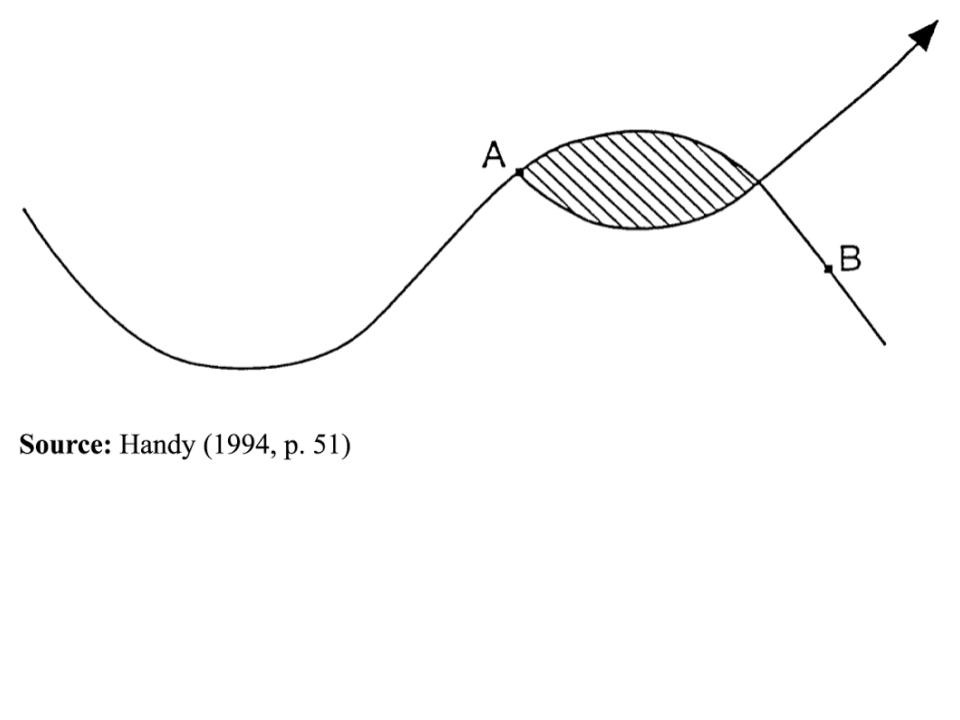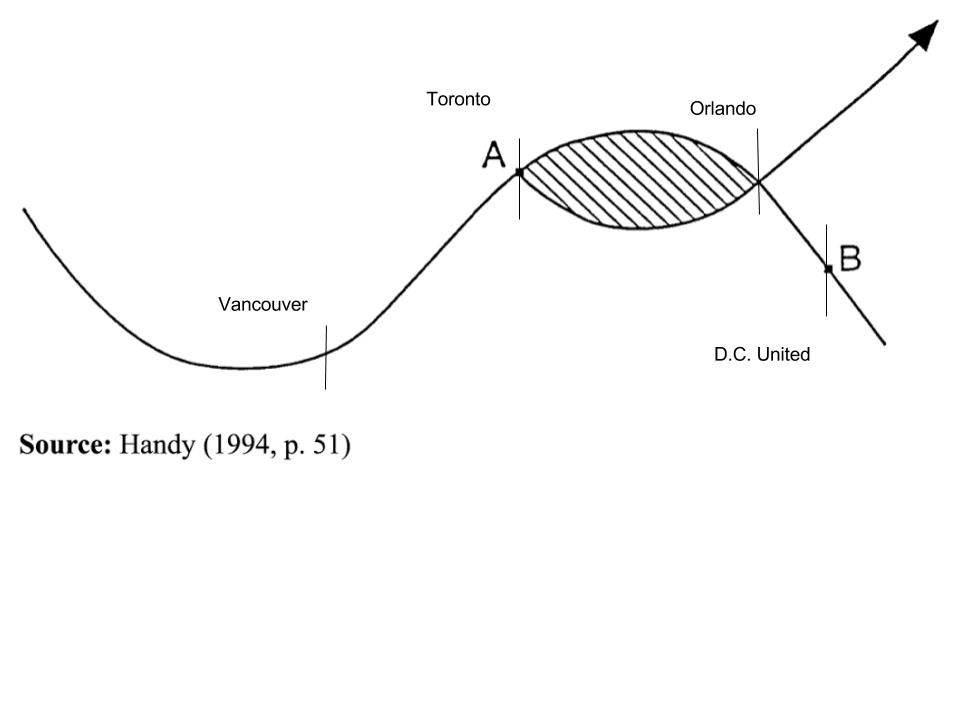A business theory can explain the Philadelphia Union’s season so far.
In 1995, a book was published by famed organizational and management behaviorist and London Business School professor Charles Handy called The Age of Paradox. It focused on the ways in which businesses change and innovate in order to maintain their relevancy. The book has become a standby for CEOs and consultants hoping to navigate an ever-changing marketplace.
The lesson is a simple one: Successful businesses must identify when their current version of success has run its course so they can determine new ways to extend that success — before it’s too late.

A smart business will begin to rebuild when they are near the peak of their initial success (A), capitalizing on profits and their positive effects on a culture of goodwill in order to build. It takes one step back in order to take two or more forward.
A failing business will ride their initial success until it has begun to wane, eager to maximize every inch of positive trajectory, only to realize that the opportunity for change and renewed growth has passed (B).
There are two ways to apply this theory, called the Sigmoid Curve, to the 2017 Philadelphia Union. They begin identically.
The optimist’s argument
 The Union’s opening day away draw with Vancouver was the beginning of a reasonably successful business cycle, the peak of which culminated in an open, entertaining, and ultimately unlucky home draw against the best team in the conference.
The Union’s opening day away draw with Vancouver was the beginning of a reasonably successful business cycle, the peak of which culminated in an open, entertaining, and ultimately unlucky home draw against the best team in the conference.
Knowing an enormous opportunity for points at home was on the other side of a deceivingly difficult two-game road stretch, the Union chose to “embrace their business model, fully committed to implementing it in all its details, while at the same time questioning whether this model needed to be replaced by a new focus” when the team returned home (Randel Consulting Associates, 2012).
The pessimist’s argument
 Again, the Union’s opening day away draw with Vancouver was the beginning of a reasonably successful business cycle, the peak of which culminated in an open, entertaining, and ultimately unlucky home draw against the best team in the conference.
Again, the Union’s opening day away draw with Vancouver was the beginning of a reasonably successful business cycle, the peak of which culminated in an open, entertaining, and ultimately unlucky home draw against the best team in the conference.
However, they apparently didn’t realize opposing scouts had learned how to neutralize players such as Ilsinho, Keegan Rosenberry, Fabian Herbers, and Alejandro Bedoya, or that the Union’s Island of Mismatched Toys 4-2-3-1 formation wasn’t a fit for current personnel. So the Union continued to run blindly down the path that had brought them some early modicum of success, only to realize too late that it was a dead end with a sign reading “Bottom of the table” and, in small print, “Union head coach: Applicants wanted.”
The pragmatist’s close
Organizations who follow the lessons of the Sigmoid Curve succeed because of the leaps they take to refresh their businesses, and they must make this leap over and over again as needs dictate.
What stage any business is along that curve, however, is difficult to determine from both the inside and the outside. Frankly, it’s a little bit like looking at a mountain range with a microscope. The problem is that you can see a lot of what’s in your lens and still miss out on the rest of the picture.
Four games into a 34-game season, the lens focused on the Philadelphia Union mountain is beginning to widen but still hasn’t shown much. What it has revealed recently, though, has undone much of the perceived good it identified to start the season. For optimists, pessimists, and pragmatists alike, much of the picture is yet to be revealed.


Good stuff Chris!
another point of view…..
Union Going Backwards……..in 2017
This current team is just awful and very hard to watch. If they continue at this pace they will finish dead last in the East with a total of 14 to 16 points. That’s the worst season ever for the U. If Curtin cannot get the team motivated and win at home he has got to go. However Ernie can shoulder most of the blame for the Unions slow start and lack of success so far in 2017.
Ernie’s Preseason Mistakes…..
#1 Underestimating Barnettas value and contributions to the success of the 2016 team. Overestimating what Bedoya can do as the # 10.
#2 Not Releasing Edu and Alberg before the start of the 2017 season. Both are wasted salaries that could have been used to get a better #10 and fill other needs
#3 Signing Simpson and expecting him to be the #1 forward. He is not a stand alone forward. He cannot score consistently as the solo forward. He is an overrated 4th division English player who had 1 remarkable season in a league the equivalent of the NASL.
#4 Signing the “I already forgot his name “Dutch left back who can’t crack the starting squad at Bethlehem Steel. Yikes
PS
Curtin better start Sapong and Herbers who at least show pace, guts and effort. Fhabino better remember he is a left back 1st not a left wing. He better get back on defense after his runs or the Union will be burned by Portland on his side all day.
Fascinating (Spock’s raised eyebrow).
.
It would be interesting to plot the U’s cycles for each season since 2010 and see if anyone is learning anything.
.
Phillies apparently overshot the learning gap and are only now beginning a tenuous ascent.
.
The U’s seven year cycle would appear to be Sisyphean by comparison.
The Phillies immediately came to mind for me too. Already said by many, but the entire season hinges on this month. I will reserve all outrage or praise until month’s end… but then… it could be a really interesting time. We shall see
To Joe B. above, a detail correction.
.
Your Dutch left back is called Giliano Wijnaldum. I am sure of his last name’s spelling, not his first. He started for the Steel against Rochester and played the full game, having started the single most creative tactical episode produced by Steel in the first half.
.
He also started for the Steel in a previous scrimmage and played 60 or so, the weekend the first team flew to Vancouver if I remember correctly.
.
You are absolutely correct that he is not putting Fabinho on the bench at the moment. He is putting Charlie Reymann on the Steel’s bench, however. Reymann is offensively more versatile than was Taylor Washington last season.
Chris, this is very creative, but I don’t think it’s applies. I think it’s something that is intended to apply to a business over the course of many years. The applicability to a team would be to one that plays the same strategy and with the same identity, successfully, over many seasons, not after a few games within a season. Our team is just searching for an identity and trying to fit its pieces together,